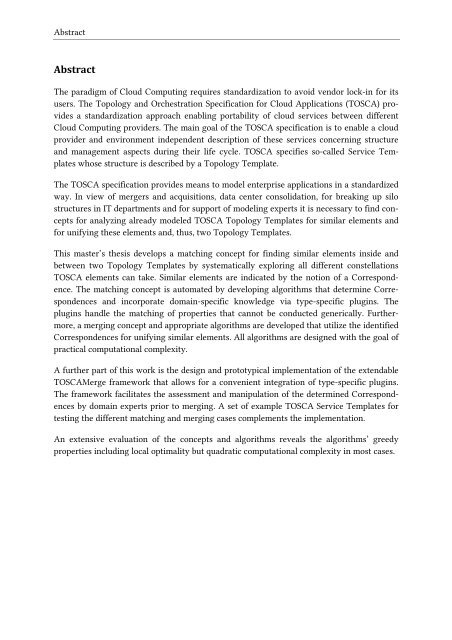Merging of TOSCA Cloud Topology Templates - IAAS
Merging of TOSCA Cloud Topology Templates - IAAS
Merging of TOSCA Cloud Topology Templates - IAAS
Create successful ePaper yourself
Turn your PDF publications into a flip-book with our unique Google optimized e-Paper software.
Abstract<br />
Abstract<br />
The paradigm <strong>of</strong> <strong>Cloud</strong> Computing requires standardization to avoid vendor lock-in for its<br />
users. The <strong>Topology</strong> and Orchestration Specification for <strong>Cloud</strong> Applications (<strong>TOSCA</strong>) provides<br />
a standardization approach enabling portability <strong>of</strong> cloud services between different<br />
<strong>Cloud</strong> Computing providers. The main goal <strong>of</strong> the <strong>TOSCA</strong> specification is to enable a cloud<br />
provider and environment independent description <strong>of</strong> these services concerning structure<br />
and management aspects during their life cycle. <strong>TOSCA</strong> specifies so-called Service <strong>Templates</strong><br />
whose structure is described by a <strong>Topology</strong> Template.<br />
The <strong>TOSCA</strong> specification provides means to model enterprise applications in a standardized<br />
way. In view <strong>of</strong> mergers and acquisitions, data center consolidation, for breaking up silo<br />
structures in IT departments and for support <strong>of</strong> modeling experts it is necessary to find concepts<br />
for analyzing already modeled <strong>TOSCA</strong> <strong>Topology</strong> <strong>Templates</strong> for similar elements and<br />
for unifying these elements and, thus, two <strong>Topology</strong> <strong>Templates</strong>.<br />
This master’s thesis develops a matching concept for finding similar elements inside and<br />
between two <strong>Topology</strong> <strong>Templates</strong> by systematically exploring all different constellations<br />
<strong>TOSCA</strong> elements can take. Similar elements are indicated by the notion <strong>of</strong> a Correspondence.<br />
The matching concept is automated by developing algorithms that determine Correspondences<br />
and incorporate domain-specific knowledge via type-specific plugins. The<br />
plugins handle the matching <strong>of</strong> properties that cannot be conducted generically. Furthermore,<br />
a merging concept and appropriate algorithms are developed that utilize the identified<br />
Correspondences for unifying similar elements. All algorithms are designed with the goal <strong>of</strong><br />
practical computational complexity.<br />
A further part <strong>of</strong> this work is the design and prototypical implementation <strong>of</strong> the extendable<br />
<strong>TOSCA</strong>Merge framework that allows for a convenient integration <strong>of</strong> type-specific plugins.<br />
The framework facilitates the assessment and manipulation <strong>of</strong> the determined Correspondences<br />
by domain experts prior to merging. A set <strong>of</strong> example <strong>TOSCA</strong> Service <strong>Templates</strong> for<br />
testing the different matching and merging cases complements the implementation.<br />
An extensive evaluation <strong>of</strong> the concepts and algorithms reveals the algorithms’ greedy<br />
properties including local optimality but quadratic computational complexity in most cases.
















